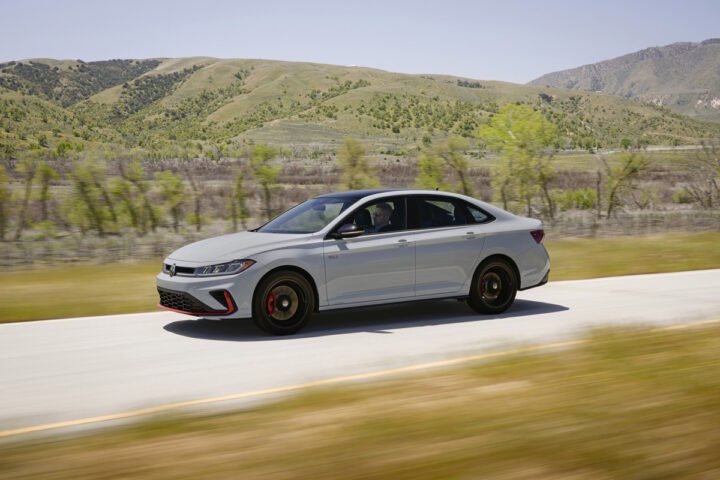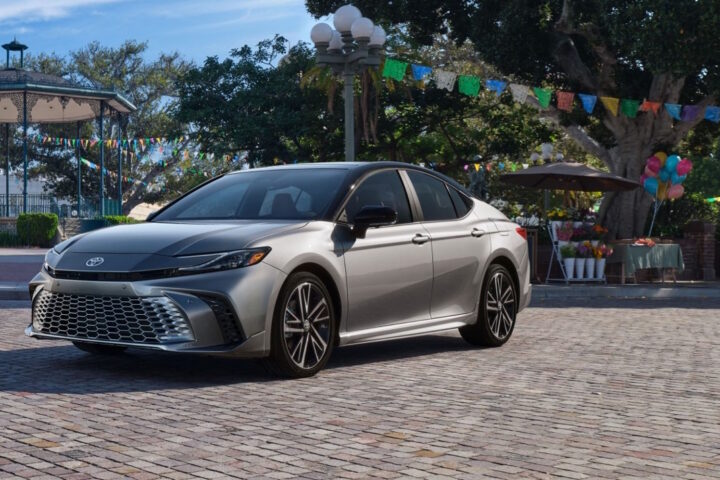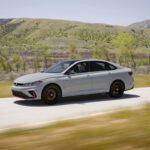I was recently invited out to visit the Bosch® Proving Grounds in Flat Rock, Michigan to experience firsthand the transportation technology that Bosch is creating for the vehicles of tomorrow. I really didn’t know what to expect, I knew that Bosch was a supplier to many automotive manufacturers and that they made everything from Batteries to Dishwashers, but I had no idea how much Bosch has impacted modern transportation.
Exploring New Automotive Technology with Bosch
This is a sponsored post on behalf of Bosch, however, the opinions are my own.
Arriving at the Bosch Proving Grounds it was a cool, overcast day, we made our way to a display area surrounded by different vehicles. Wandering around the displays that included cars, motorcycles, big rig trucks, UTVs, and even a tractor it was apparent that it was going to be a fun event. After a short introduction to the company and some background on each of the different technologies, we would be experiencing that day we were free to head out and take advantage of the vehicle demonstrations.
The first new technology that I experienced was Bosch’s new ‘Perfectly Keyless’ connected solution for vehicle access and starting using a smartphone. The demonstration was done using a Ford Mustang and a few smartphones. The secure Bluetooth signal allows a user to unlock the car and start it, essentially turning your phone into a proximity key. The real innovation is the user access feature that allows the owner of the car to grant and revoke access to other users of the app to their vehicle. This technology will become more and more important in the sharing economy with peer to peer car rental sites like Toro, and commercially with services like Amazon car delivery.
Heading over to the Special Surfaces Area (Off Road) section of the proving grounds, Bosch had three unique off-road UTVs that were demonstrating three very different technologies. The first a Semi-Active Damping Control which uses algorithmic real-time suspension controls to improve ride and control in changing road conditions. After a few laps, it was easy to tell when the system was engaged and when the dampeners were static.
The next vehicle was the Nikola NTZ an all-electric UTV with the equivalent of 500hp via four-wheel-independent motors. With a 0-60 time, just under 3.5 seconds and 20” of travel on all four corners the Nikola NTZ is a serious off-road vehicle with amazing capability.
The third and perhaps the most interesting of the UTVs was the four passenger Maverick that had been fully modified to be completely remote controlled. The best part is that the car looks unmodified from the outside and a driver can even drive the car from the driver’s seat or from a classic trigger pull remote control like you had as a kid. Watching the pedals and steering wheel move independently was impressive and really showcases Bosch’s capabilities for future autonomous or remote driven vehicles.
From there we drove to the Vehicle Dynamic Area where we had the chance to try out some production and future technologies. The first production tech that was on display was a Cadillac that featured a redundant electronic steering system. As I drove the car around the course I was able to feel how the car would feel if the power steering system were to fail and how Bosch’s fail-operational steering allows the driver to maintain control without even noticing that primary steering system has had a failure. This type of technology is required in autonomous driving and is paving the way for the wider integration of autonomous driving systems in more vehicles in the future.
Next, I hopped into a new Chevrolet Corvette Z06 that features Bosch ESP® from the factory. With a Bosch test driver, we took the car out on the test track which featured a banked turn, braking area, and other obstacles to simulate driving conditions that would showcase the Performance Traction Management system, ABS system, and launch control. The grip and performance of the Z06 using Bosch technology really showcase why these cars do so well at the local track days.
My next ride was in a Jaguar F-Pace that was equipped with an experimental new technology that will takes driver assistance to the next level. While it is likely you have driven in a car that has automatic lane keeping, adaptive cruise control, or collision avoidance. This system takes all of those to the next level with the computer not only sensing objects but classifying them as specific object types allowing it to make decisions on how to respond to obstacles in real time. In this case, the demonstration was set up for the system to identify and avoid running over cyclists. As we pulled up to the test area the screen was showed the software identifying and classifying the cyclists as well as other objects as we approached the robotic bike rider at about 25kph the vehicle detected that the cyclist would cross our path and performed an emergency stop without any driver input.
There was so many new technologies that we took in at the Bosch Mobility Experience that I have much more to write about, from their revolutionary parking tech that will change the way drivers find parking in major cities to motorcycle innovations that make riding safer and riders more connected Bosch is changing the future of transportation and I can’t wait to see what is next.
Be sure to check out my YouTube video below from the day and let me know what new technologies you would like to see in your transportation future in the comments below.
























